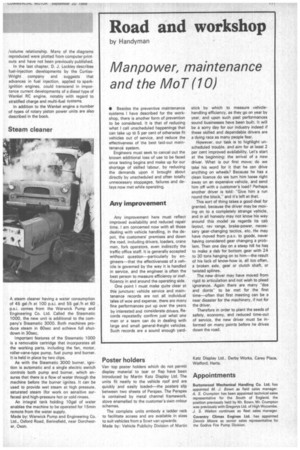Road and workshop
Page 115

If you've noticed an error in this article please click here to report it so we can fix it.
by Handyman
Manpower, maintenance and the MoT (1 0)
• Besides the preventive maintenance systems I have described for the workshop, there is another form of prevention to be considered. It is that of reducing what I call unscheduled happenings that can take up US 5 per cent of otherwise fit vehicles out of service, and reduce the effectiveness ot the best laid-out maintenance system.
Engineers must seek to cancel out the known additional loss of use to be faced once testing begins and make up for our shortage of skilled labour, by reducing the demands upon it brought about directly by unscheduled and often totally unnecessary stoppages, failures and delays now met while operating.
Any improvement
Any improvement here must reflect improved availability and reduced repair time. I am concerned now with all those dealing with vehicle handling, in the depot, the customers' premises and down the road, including drivers, loaders, crane men, fork operators, even indirectly the traffic office staff. It is generally accepted without question—particularly by engineers—that the effectiveness of a vehicle is governed by the way it is handled in service, and the engineer is often the best person to measure efficiency or inefficiency in and around the operating side.
One point I must make quite clear at this juncture: vehicle service and maintenance records are not all individual tales of woe and expense, there are many fine performances put up over the years by interested and considerate drivers. Records repeatedly confirm just what one man or a team can do in dealing with large and small general-freight vehicles. Such records are a sound enough yard stick by which to measure vehiclehandling efficiency, as they go on year by year, and upon such past performances sound businesses have been buiI. It will be a sorry day for our industry indeed if these skilled and dependable drivers are a dying race as many people fear.
However, our task is to highlight unscheduled trouble, and aim for at least 2 per cent improved availability. Let's start at the beginning: the arrival of a new driver. What is our first move: do we take his word for it that he can drive anything on wheels? Because he has a clean licence do we turn him loose right away on an expensive vehicle, and send him off with a customer's load? Perhaps another driver is told: -Give him a run round the block," and it's left at that.
This sort of thing takes a good deal for granted, because the driver may be moving on to a completely strange vehicle, and in all honesty may not know his way around this model as regards its cab layout, rev range, brake-power, necessary gear-changing tactics, etc. He may have moved from p.s.v. to goods, never having considered gear changing a problem. Then one day on a steep hill he has to make a dab for bottom gear with 24 to 30 tons hanging on to him—the result of his lack of know-how is, all too often, a broken axle, gear or clutch shaft, or twisted splines.
The new driver may have moved from rigid to articulation and not wish to plead ignorance. Again there are many "dos and donts" to be met for the first time—often that first meeting can be a near disaster for the machinery, if not for the driver.
Therefore in order to plant the seeds of safety, economy, and reduced time-out of service, the new driver must be informed on many points before he drives down the road.


















































































































































































































































































































































































